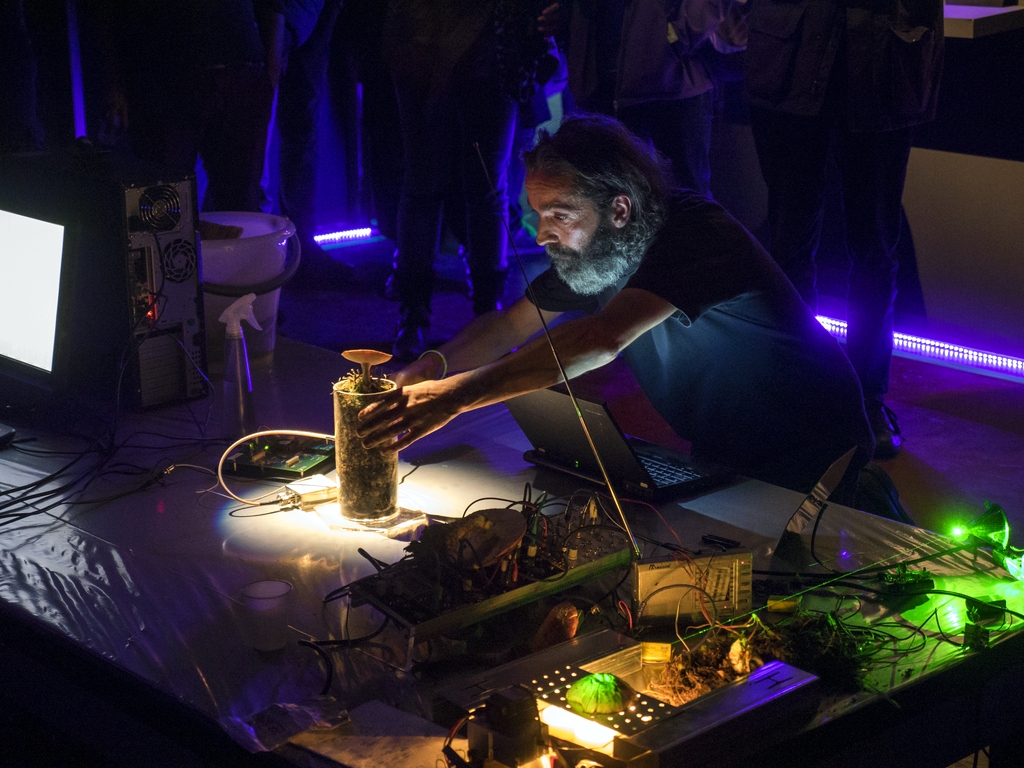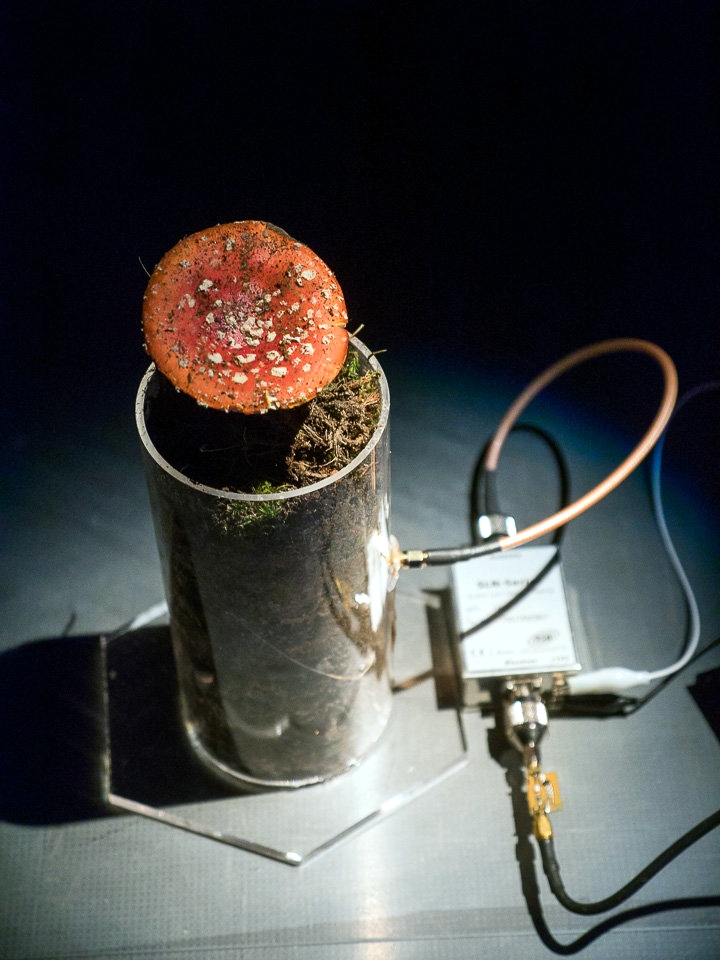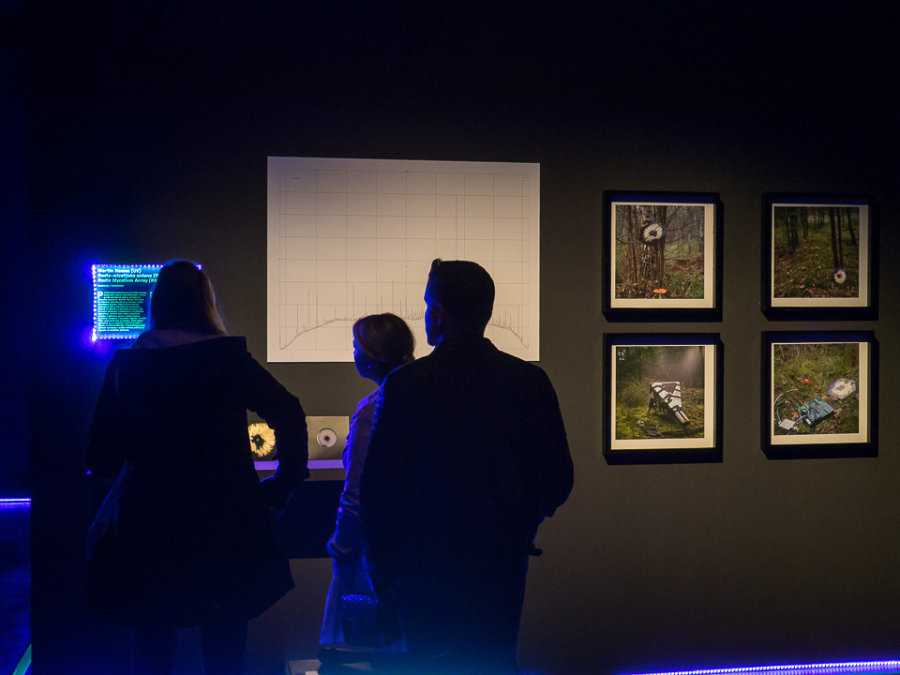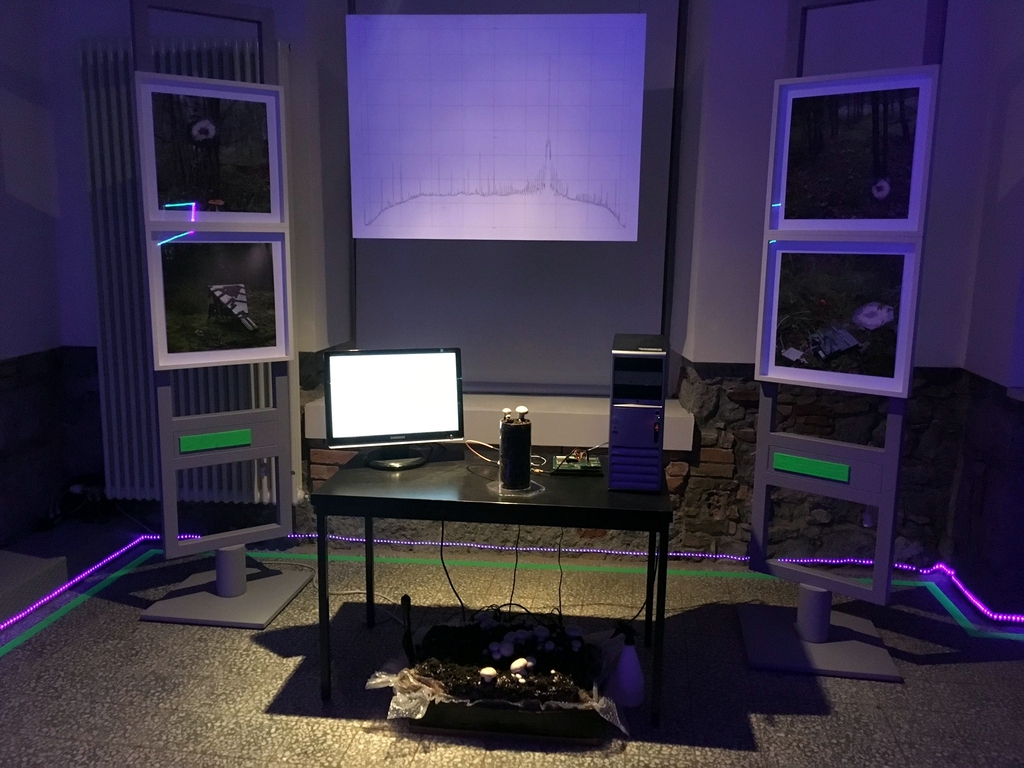Radio Mycelium Array [RMA] 2017+

Installation for Amanita Muscaria mushrooms, software defined radio, desktop computer, custom electronics, vinyl, images and gold etched antenna.
Symbiotic ur-networks of silent fungal and root chatter and earth vibration, named chemical gradients tasted by rooty and human tongues fruit forest-wide in fairy rings, rising up in form and outgrowing Jodrell bank and Arecibo, outclassing them unknown in bringing down the stars to earth.
Martin Howse and Nik Gaffney. Approaching the Inexplicable. 2014
Noting simple parallels between the scaled formations of radio telescope arrays, and the arrayed forms of certain mushroom bodies such as those of Amanita Muscaria, the artist aims to further explore this spored coincidence of cosmos and micro-cosmos, initiating the first forest Radio Mycelium Array.
Conventional radio telescope arrays make use of a technique called interferometry to combine signals received on multiple smaller antennas, creating a larger, more precise view of the electromagnetic universe. In the case of the RMA, the arrayed Amanitas act as receiving antennas for deep space signals, to be combined in underground mycelial electrochemical signals. Star dust and mushroom spore combine imaginatively, with both technologies provoking potentially meaningful earth and cosmic signals.
Radio Mycelium Array(RMA) is exhibited both as a prototype (mushroom bodies connected to a digital interferometer device and display), and as documentation of "working" forest studies with similar equipment. Audio recordings of received signals are also made available (inscribed on vinyl in sleeves printed with copper spore patterns from the Amanita Musacria mushroom which follow the same spore design as used for the antenna). A performance accompanies the installation opening.
Radio Mycelium Array(RMA) has been exhibited as part of:
Touch Me Festival 2017: the Invisible Around Us, Zagreb
Touch Me 2017: Museum of Contemporary Art in Rijeka
With thanks to Tereza Teklic and all at Kontejner, Zagreb.
Further images

[Touch Me Festival 2017, MRA performance]

[Touch Me Festival 2017, MRA installation detail]

[Touch Me Festival 2017, MRA installation]

[Museum of Contemporary Art in Rijeka 2017, MRA installation]
Code and hardware
Antenna: https://github.com/shiftregister/shiftregister/tree/master/spore_antenna
Softwares:
#!/bin/bash
while :
do
/usr/lib/uhd/examples/rx_ascii_art_dft --freq 1420e6 --rate 5e5 --gain 40 --dyn-rng=110
done
#!/usr/bin/env python2.7
# black hole plots a la ouroboric.py
# data from USRP in what form? what do we need to run to get say FFT data in a very simple format we can then parse?
### /usr/lib/uhd/examples/rx_ascii_art_dft --freq 1420e6 --rate 5e5 --gain 60 --bw 5e5 --ref-lvl -90
from datetime import date, datetime
from math import sin, cos, pi, asin, radians as rad,degrees as deg
import ephem
import subprocess as sp
import time
from time import sleep
import numpy as np
mylocation = ephem.Observer()
mylocation.lat, mylocation.lon = '45.791196', '15.975645'
# This is the location of the zagreb gallery!!! POGON Jedinstvo 45.791196, 15.975645
min_alt = ephem.degrees('10:00')
milkyway_visual = ephem.readdb("Milky Way Visual Center,f|M|F7,18:55:03.06,-30:28:42.30,3.00,2000")
milkyway_sagastar = ephem.readdb("Milky Way Black Hole (Sgr A*),f|M|F7,17:45:40.0409,-29:00:28.118,25.00,2000")
# https://en.wikipedia.org/wiki/Sagittarius_A*
milk = milkyway_sagastar
sun = ephem.Sun()
moon = ephem.Moon()
while(1):
tmp = sp.call('clear',shell=True) # clear screen
print " Radio Mycelium Array(RMA)"
print " +++++++++++++++++++++++++"
print
print "RMA: Symbiotic ur-networks of silent fungal and root chatter and earth vibration, named chemical
\ngradients tasted by rooty and human tongues fruit forest-wide in fairy rings, rising up in form
\nand outgrowing Jodrell bank and Arecibo, outclassing them unknown in bringing down the stars to earth."
# print time
print
mylocation.date = datetime.utcnow()#
milk.compute(mylocation)
print "Milky Way Black Hole (Sgr A*):",
print ephem.localtime(mylocation.date), deg(milk.az),deg(milk.alt)
print
print "ASTRA position: az/alt"
# degrees is starting at 304 [wrap 360] to 124 (180
# for back wall - for front window we do 120 to 300 say
# !!!!we would need to figure this out from Zagreb gallery!!!
# so facing North which is back wall...
# NESW - so start in west and go to east = 180degrees from 270 to 90
degg=deg(milk.az)
if degg>90 and degg<270: # upto 300 - 180
xcoord=int((degg-90)/2.25)
else:
xcoord=-1
if deg(milk.alt)>0.0:
ycoord=np.ceil(deg(milk.alt)/9.0)
else:
ycoord=-1 # below horizon
# print xcoord,ycoord
for y in range(10):
print"|",
if (10-ycoord)==y:
if xcoord>0:
for x in range(xcoord):
print "",
print "*"
else:
print
print"--------------------------------------------------------------------------------"
print
sleep(1)